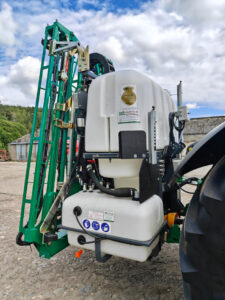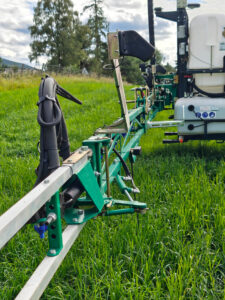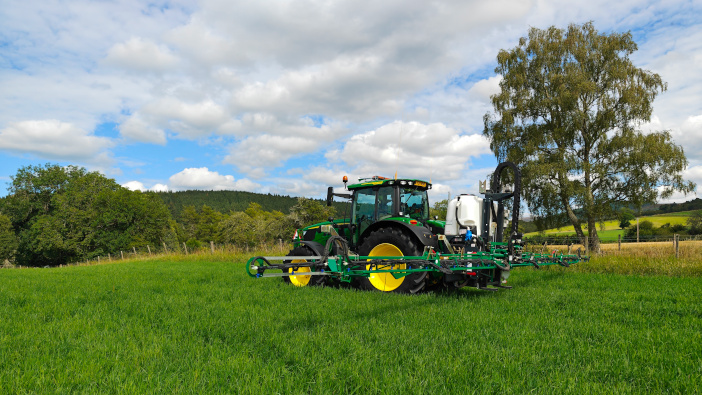Developed to tackle problem weeds in grassland, the SKAi system from SoilEssentials Ltd is offered both as a retrofit camera and AI-driven computer system for existing sprayers, or as a custom-built mounted sprayer.
The model provided by SoilEssentials is available with boom widths of 12m, 15m or 24m, with cameras placed at 3m intervals, with another mounted at the front of the tractor to ensure full coverage. A GPS receiver is mounted directly on the sprayer so that the computer knows exactly where in the field the images are coming from, at speeds of up to 14kph.
Colin Taylor explains that the cameras take an image 20 times per second, monitor the area and any potential weeds until the boom passes over. “Operators can set an accuracy threshold within the system, and the AI will constantly monitor a potential weed, using its modelling data to assess the image until the boom reaches that point. If the system is certain that it has identified the weed, then it will apply a dose of herbicide.”
Tackling key weeds
The system has been trained to identify docks and thistles currently, with new modes being developed to tackle nettles and ragwort. “We’ve also got a mode that can identify volunteer potatoes, which has been a major issue for growers,” Colin adds.
SKAi fitted sprayers come with their own integrated Wi-Fi modem. This not only enables operators to access the app and adjust application plans or accuracy thresholds on the move, but also enables SoilEssentials to access images from machines working and use the data collected to continuously train and refine the recognition software. This also enables updates to the system to be sent out remotely, downloaded and installed.
Data from previous trials with the machine show an average 85% saving in chemicals when using SKAi. “In a 1.42ha field, the sprayer was only active for around 0.68ha, representing around 48% of the field,” explains Rod Armour.
 A modular build
A modular build
When retrofitted to an existing sprayer, which can theoretically extend to any boom width, although this will increase the price due to the additional cameras and ECUs, the SKAi system simply links up to the sprayer setup and controls the nozzles to regulate herbicide application.
On the complete SKAi sprayer, it has a modular build to offer increased versatility. “Because of the reduction in chemical use, it has a 200-litre chemical tank and a 1,000-litre water tank,” explains Colin. “The mixing is controlled through the system, so only small amounts of chemical are diluted and circulated at any point, meaning that operators don’t have to estimate how much chemical will be required for each job.”
However, SoilEssentials also want the machine to be suitable for broadacre operations when required. For small fields and problem areas, the sprayer can be used as is, with the individual nozzle system utilised for accurate section control and the chemical and water tanks working continuously to supply product to the boom.
For larger areas, the SKAi sprayer can be specified with a changeover kit that enables the full 1,200-litre capacity of the machine to be utilised as a normal sprayer. Again, Colin notes that operators can still use all the additional technology, including the SKAi camera system (in relevant weeds) and the individual nozzle control.
 There is also the option of an automatic dosing pump, which will continuously feed chemical into the 200-litre tank, keeping it topped up. This provides a constant feed of chemical mix for areas where operators aren’t sure of the weed pressure.
There is also the option of an automatic dosing pump, which will continuously feed chemical into the 200-litre tank, keeping it topped up. This provides a constant feed of chemical mix for areas where operators aren’t sure of the weed pressure.
System for the future
While the focus remains on grassland weeds for the time being, the long-term plan is to develop modes for vegetable and cereal weeds.
“It takes a long time and significant investment to develop these programmes,” Colin explains. “It won’t happen overnight, but as more people adopt the SKAi system, we can continue development and target other volunteers and weeds.”



